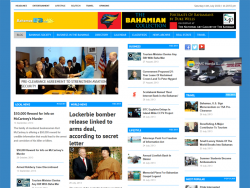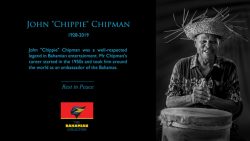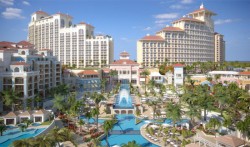Marine engineer Augusto Villalon of St James City, Florida, was escorted into an elegant room at the Ministry of Foreign Affairs. It was November last year and he was on a mission to plead for the release of two good friends who, plucked from the Gulf Stream seven months earlier in a bold attempt to escape Cuba, were imprisoned at the Carmichael Road Detention Centre.
Mr Villalon, known to his friends as “Kiko”, had wanted to meet with Prime Minister Perry Christie. But, he said, “I was not received.”
Instead he was directed to the Ministry of Foreign Affairs. While he waited for the officials he was to meet, he took in the details of the room. He was fascinated.
“The room at the offices of the Foreign Ministry is a very elegant one,” he said. “It contains what appears to be period furniture perfectly upholstered in velvet, beautiful decor all over, gorgeous floor coverings, lovely draperies at the windows. The room has two doors, one towards the entrance lobby where I came in and one on the other side of the room where Ms Marylyn Zonicle, Under Secretary of Foreign Affairs, entered first and sat on the sofa.
“Later,” he said, describing the room’s every detail, “Ambassador Leonard Archer, the Plenipotentiary Ambassador to Caricom and permanent Ambassador to Surinam, elegantly dressed in a pin-stripe suit, entered and joined us. The Cuban flag was on a pole about two feet lower than the ceiling and draped around the pole. There was absolutely no Bahamian flag or any other flag in the room.”
He was struck by the incongruity of a Cuban flag in the main reception room of the Bahamas’ Ministry of Foreign Affairs.
The meeting had been arranged by Ambassador Luther Smith, special assistant to the Prime Minister.
Mr Villalon had explained his mission to Mr Smith, presenting him with a package of documents to bring him up to date on his group’s efforts to free Doctors Marialys Darias Mesa and David Gonzalez Mejias. The two doctors were on their way to join their families in Florida when they were picked up by the US Coast Guard patrolling Bahamian waters with a Bahamian “ship rider”.
“We met for 45 minutes,” said Mr Villalon, “and I handed them my package of information. Mr Archer stated that they hoped I understood that they would have to consult with the Cuban government and their Ambassador in Nassau.”
Mr Villalon said he fully understood the position. He had seen the Cuban flag – “the only flag in the room in which we were meeting.”
Mr Villalon’s story goes back to the Spring of 2002. That year two Cuban families were among the annual 20,000 Cubans to win the “American lottery.”
This lottery, the result of a Joint Communique, signed by the US and Cuba on September 9, 1994, was negotiated to regulate the flow of Cubans into the United States. It was initiated after the disastrous Mariel boatlift in the eighties that flooded Florida with 150,000 Cubans, many of them criminals and mental degenerates.
The agreement was that Castro would permit 20,000 of his citizens, who won the immigration lotterv. to migrate to the United States. The US agreed to receive them.
Ihovany Hernandez, an electrician, his wife, Dr Marialys Darias Mesa, a dentist, and their one-year-old daughter, Maria Laura, applied and won visas that year. Also selected for the lottery were Dr David Gonzalez Mejias, a dentist, and his wife, Dayami, with their two children, Carlos, 14, and Flavia, 7.
During excited preparations to start a new life in a free country, the two families received news that the Cuban government would not permit the dentists to leave. They were professionals who were too valuable to the state. After all Castro had offered medical aid to Caribbean neighbours, the Bahamas included, and he needed every doctor and dentist that Cuba had.
Broken Promises
They were promised that if they worked for the state for another three years, they would be allowed to leave. They agreed. The two families also decided that family members who were still free to go should leave for the US, where three years later the two dentists would join them.
Three years dragged on. In the meantime, Ihovany settled in Cape Coral, Florida, where he had a brother, while Dayami and her two children settled in Tampa, where they had friends. It was decided that little Maria Laura should remain in Cuba with her mother The two families in Florida worked hard to establish their homes and prepare for the day they would be joined by their spouses.
At the end of three years, the dentists applied for their promised release. They were horrified to learn that the Cuban government had changed its policy. The dentists were not to be released. They had become “indispensable”, they were told. They would have to remain in Cuba another two years. Realising that the “two year” promises would never end, they, in desparation, “boarded a boat and sailed out into the Gulf Stream and the dream of America,” said Mr Villalon. That was at the end of April last year. Later the same night they were picked up by a US Coast Guard cutter after being marooned at Elbow Cay in the Cay Sal area. They were taken to Freeport, where they were turned over to the Bahamas government.
Little Maria Laura, now four years old, was left in Cuba with her two grandmothers. She has not seen her father in three years, and her mother in 10 months. Her mother did not want to risk the Gulf crossing with her young daughter, knowing that if she made it to the other side alive she could send for her daughter, who has a US visa. “I heard about the problem two days later,” said Mr Villalon, “when Marialys and David, were imprisoned in Nassau for crimes they never committed against a country they had never been in.”
“My district Congressman Connie Mack IV – a personal friend – was the first one to jump to join our team, followed shortly by Governor Jeb Bush, Ambassador John Rood, Senator Mel Martinez and others. I started working with US Ambassador Rood in Nassau and with his assistant, Mr Mike Taylor, and Dr Brent Hardt to attempt to secure the doctors’ release. In June we had Marialys and David write a letter, with the assistance of local lawvers requesting political asylum and began negotiating with the Bahamas Foreign Minister and the Immigration department… to no avail,” said Mr Villalon.
“The legal point here,” he said, “is that these doctors have permits to enter the US and the government – Homeland Security Department – has communicated to the government of the Bahamas this fact and stated that as soon as the Bahamas releases the prisoners to the American Ambassador in Nassau, the US will fly them out of the Bahamas immediately.”
Mr Villalon said that from July last year to the present they have had neither an acknowledgment nor a reply to their letters requesting asylum. “To this date the government has failed to look into this in spite of the fact that we were told that they would process the request within five to seven weeks.”
Almost weekly since last September, he continued, American Ambassador Rood has met with Prime Minister Christie and/or with Foreign Minister Mitchell to no avail. Every time the government officials mention that they are working on a solution, but nothing is done. We have never yet, officially, been able to know what the impasse is all about.”
“On November 15,” he said, “the Bahamas Cabinet refused for the second time to release these two innocent people. On December 12, I travelled to Nassau with Marialys’ husband. We attempted to talk with the Prime Minister, but he could not see us. He sent his assistant Luther Smith to talk with us.”
Seven more weeks of negotiations passed with no indication that the dentists would be released any time soon. It was then that the group decided that it had no alternative but to go public and “ask for voices of indignation to demand loudly that these two Cuban refugees be allowed to take advantage of the offer from the USA to become legal immigrants and ultimately American citizens.”
By then five US Congressmen, two Senators and others had joined their ranks.
The Congressmen, led by Connie Mack, met with Bahamas Ambassador Joshua Sears in Washington. Congressman Mack made it clear that the US had awarded visas to the dentists and they wanted
the Bahamas government to release them within 30 days, ending January 16.
Ambassador Sears made a special trip to Nassau, presumably to confer with the government.
ᅠᅠᅠᅠᅠᅠᅠᅠ
On February 2 and 3, Mr Villalon with Marialys’ husband was again in Nassau to try to meet with Prime Minister Christie and the press “in an ᅠattempt to find a solution acceptable to all parties.” This was their last visit to the ᅠBahamas.
“We believe,” he said yesterday, “that if the good people of the Bahamas knew the truth about this case, they would join their voices with ours in protest of the injustice of it all.
“We have tried,” he said, “God knows we have – and now we feel as if our backs are against a wall. We are therefore humbly asking for your help and demanding that the doctors be released from the Bahamian prison into the custody of the United States. Only in that way will justice be served. They deserve no less.
In the House of Assembly on Wednesday Mr Christie announced that he had made the final decision on whether the two doctors should be repatriated to Cuba or released to the United States.
He said preparations for the deportation of the two Cubans are underway and he will inform the public “in due course” of the nature of his decision in this matter.
Referring to his meeting with Florida Governor Jeb Bush last week, Mr Chrisrie said: “As I told Governor Bush, this government of a black country is discriminating against Haitians in favour of how we deal with Cuban nationals. I am refusing to do that. You have a different policy in dealing with Haitians than you do when dealing with Cubans.
“It’s happened in the US. I told President Bush I am not going to condone it,” he said.
Source: The Tribune – Nassau, Bahamas



